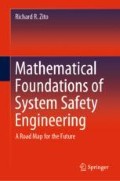Abstract
It is traditional in system safety engineering practice to enumerate system hazards in the worksheets of the Preliminary Hazard Analysis and the Final Hazard Analysis. The first compilation details hazards at the beginning of a program, while the latter describes hazards at the end of a program after some mitigation has taken place during system development. Hopefully, there are fewer hazards after development than before. In addition to the worksheets of these two analyses, there corresponds Qualitative Risk Characterization charts and, based on the entries in these, a program administrator must decide if a system is “safe”. This decision may be based on need as well as purely safety considerations. Clearly, human opinion as to what constitutes an acceptable system can never be completely eliminated. But, is there a more objective way to make decisions than opinion? This chapter describes a safety criterion based on a comparison of real system risk with the risk of an ideal Model Infinite System (MIS) having an infinite number of subsystems and possible failure modes.
Access this chapter
Tax calculation will be finalised at checkout
Purchases are for personal use only
References
Anon. WISE Series A, Course 5. Retrieved December 18, 2007, from http://63.134.199.73/nw/lms/LmsCourses/w0105_0/player.html.
MIL-STD-882D. (2000, February 10). Standard practice for system safety. Washington DC: Department of Defense.
Meyer, P. L. (1970). Introductory probability and statistical applications (2nd ed., p. 199). Reading, Mass.: Addison Wesley.
Gradshteyn, I. S., & Ryzhik, I. M. (1965). Table of integrals series and products (4th ed., pp. 307 (sec. 3.32, subsec. 3.322, integrals #1 and # 2), 930 (sec 8.25, subsec. 8.250, integral # 1), 306 (sec. 3.32, subsec. 3.321, integral #1), or alternatively to pp. 306 see pp. 931 (sec. 8.25, subsec. 8.253, integral #1)). New York, NY: Academic Press.
Anon. (2016). Private Communications, Aircraft Maintenance, 1840 E. Valencia Ave., Tucson AZ 85706, (520) 445-6300.
Thomas, R. W. I., Eichelberger, M. J., & Lee, M. (2017). The theory of risk uncertainty reduction. In 35th International Systems Safety Conference Proceedings, Albuquerque, NM, 21–25 August 2017.
Thomas, R. W. I., Eichelberger, M. J., & Lee, M. (2018). The theory of risk uncertainty reduction. Journal of System Safety, 54(2) (Summer/Fall).
Ref. [4] p. 310, sec. 3.351, #1 and pp. 365–522.
Author information
Authors and Affiliations
Corresponding author
Rights and permissions
Copyright information
© 2020 Springer Nature Switzerland AG
About this chapter
Cite this chapter
Zito, R.R. (2020). The Risk Surface. In: Mathematical Foundations of System Safety Engineering. Springer, Cham. https://doi.org/10.1007/978-3-030-26241-9_4
Download citation
DOI: https://doi.org/10.1007/978-3-030-26241-9_4
Published:
Publisher Name: Springer, Cham
Print ISBN: 978-3-030-26240-2
Online ISBN: 978-3-030-26241-9
eBook Packages: EngineeringEngineering (R0)

